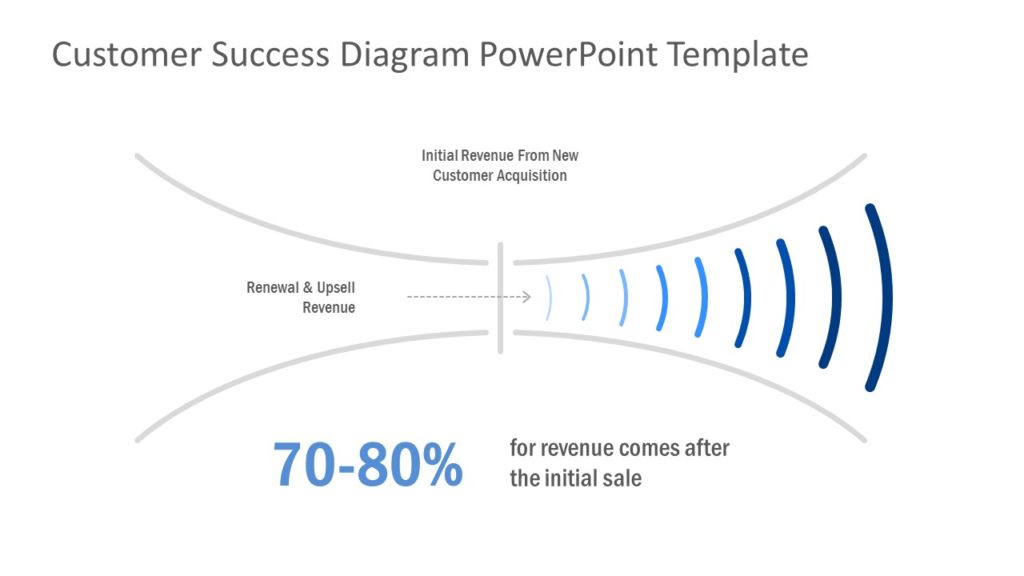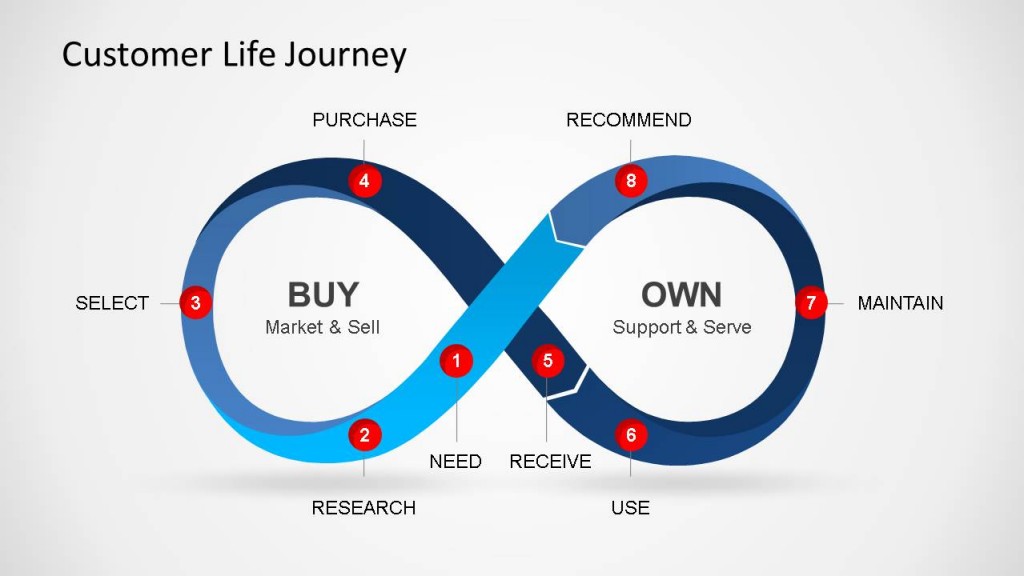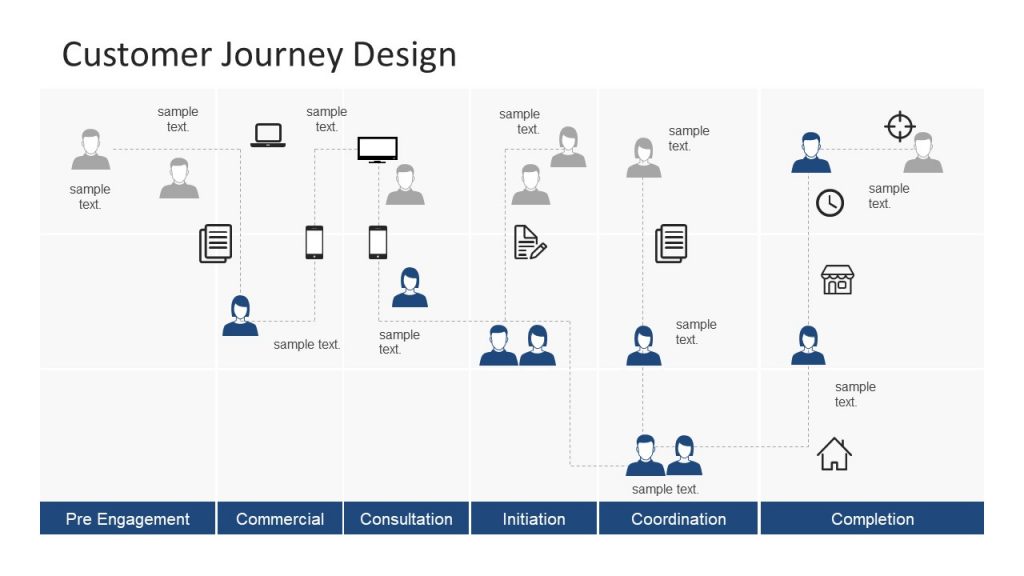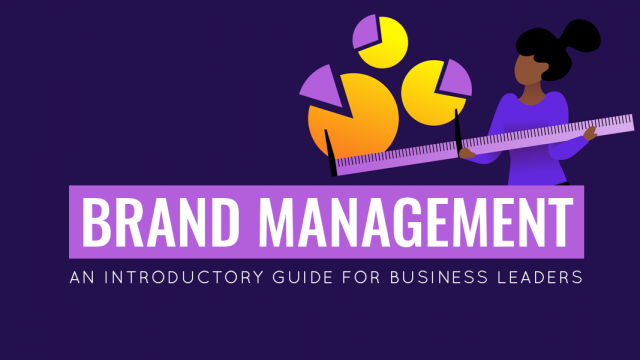
The customer success movement is getting stronger year over year. In 2019, 83% of Customer Success teams increased in size. This year, even more organizations plan to invest in new customer success management programs to ramp up their service levels. But what does customer success mean? Let’s dig in together!
What is Customer Success
The Customer Success Association has you covered here:
Customer Success is a long-term, scientifically engineered, and professionally directed strategy for maximizing customer and company sustainable proven value.
In short, it’s the way you ensure that your customers are getting the most value they can out of your products and services. They have an in-depth understanding of all your product features, take the most out of the different service models available to them and, in general, feel positive about their experience with your brand.
The “delight factor” is particularly important as it’s the one to drive you more sales and profitability in the long run. In fact, customers across the board will tell more people about poor experience (15 people on average), than about a good one (11). And as we all know, word-of-mouth and voice of customer data go a long way.
The goal of your customer success program is to strategically maximize the odds of every customer having a great experience with your brand and help them overcome potential frustrations at different stages of their life-cycle.
To accomplish that, most customer success plans incorporate integration of functions and activities from Marketing, Sales, Customer Training, Customer Service, and Support.
Customer Success vs Customer Service — What’s the Difference?
Client success is a continuous effort in ensuring that your customers are on the right track. Customer service is a more reactive approach that assumes post-factum help to experienced problems.
Companies with an established customer success life-cycle constantly analyze and brainstorm where a customer may get a potential hitch and try to mitigate those inefficiencies, preventing their customers from achieving the desired outcome.
A simple example would be a digital bank that reduced the number of required forms for opening a new checking account and introducing auto-fill options, rather than waiting until some customer complaints that they couldn’t open a new account.
In essence, the goal of customer success management (CSM) is to create real-time visibility into common customer issues and allocate sufficient resources for guiding the customers through bottlenecks.
What Does a Customer Success Manager Do?
Customer success managers usually have cross-domain knowledge, product management experience, and strong communication skills. On a day-to-day basis, they have the following responsibilities:
- Retain and nurture key accounts via regular customer interactions.
- Perform customer onboarding, strategize and deploy new training programs/resources.
- Work on maintaining and updating customer journey maps.
- Create education and helpful content for the clients and make sure it reaches the right targets.
- Participate and advice on the sales life-cycle and up-sells.
- Act as customer advocates. Exchange customer insights and knowledge with other teams to drive product development.
Why Customer Success is So Important
Customer Experience (CX) is the new battlefield for brands as it has overtaken price as a key factor impacting purchase decisions both among B2B and B2C buyers.
As we wrote earlier, customer-centricity is now the key to winning more business:
- Most shoppers are no longer enticed by products alone — they also crave ‘an experience’ for the price they pay such as fast shipping, added training, attractive user interfaces, etc.
- Online company reputation is an asset that is too costly to compromise. Customer care plays a great role in nurturing your brand perception.
- Personalization and emotional connectivity are driving profitability. Again, these metrics are hard to maximize without a customer success strategy.
Ultimately, a strong customer success process lets you walk away from aggressive sales and adopt a product-led growth strategy.
What is more, companies with mature customer success programs also enjoy:
- Higher customer retention levels
- Lower customer acquisition costs
- Lower churn rates
- Organic brand promotion
- Higher profitability as a result of all the above
How to Set up a Customer Success Program
Now that you know your “whys”, let’s take a closer look at how your company can build a viable strategy and assemble a winning customer success team.
To be successful, your program needs to be based on the next three pillars:
- In-depth customer knowledge
- Deep expertise and understanding of the product being sold
- Industry expertise and business domain knowledge
Let’s further unbundle every one of these points.
Determine What “Success” Means for Your Ideal Buyers
As Mary Barra, Chair and CEO, General Motors, well said:
“My metric for success can be summed up in one phrase: earn customers for life.”
The goal of any customer success specialist is to retain as many customers as possible. But to make that happen, they need to figure out two important things:
- Who is it exactly that you want to “earn for life” a.k.a. your ideal buyer persona?
- What will it take to entice them a.k.a. what does success mean for that person?
Now if you didn’t formalize your ideal buyer personas, get back to your drawing board. Here are several helpful templates for that:
Those who are past that step, should focus on gauging what success is. The shortcut way to gauging success is running a quick Net Promoter Score (NPS) survey. Doing so will help you identify your best, most active customers.
Typically, anyone with an NPS score of 9 or 10 will be pretty eager to speak to your customer service representative or dedicated customer success manager and explain what they like and don’t like about your product.
Remember: qualitative data and direct customer interviews are the best sources of customer success insights. This data is the not-so-secret sauce of customer-centric companies.
Develop a Preliminary Roadmap for Reaching the Success
Use the insights and feedback you’ve obtained from your Promoters to update your customer journey roadmaps.
In particular, you should highlight the areas where people faced the most challenges e.g. struggled to onboard, didn’t understand how a feature worked, and so on. To identify all the likely bottlenecks, ask your CSM team the following questions:
- Which outcome is the most desirable at every stage?
- What added value can we provide at every step?
- Are there any particular steps where your product/service falls short?
- Can we identify exactly when the customer gets unhappy and prevent that? How?
- Are there any other “red flags” of disengagement that you are aware of? What can be done about those?
Encourage your team to emphasize with the customer and proactively think about how the lackluster frustrations can be avoided.
Helpful template: Empathy Map Canvas
Formalize the Key Success Milestones
Success milestones are the steps your customer takes to attain their desired outcome. The desired outcome is a two-pronged notion that includes:
- Required outcome — the goal your customer wants to accomplish
- Appropriate experience — how they want to achieve it
The latter is why they chose you over another competitor. For instance, someone may opt for Google Slides over PowerPoint, because Google offers a free, simple way to collaborate on presentation design.
Throughout their lifecycle, your customers will have a bunch of ever-evolving goals and respective success milestones. Knowing this is essential for two reasons:
- You can pinpoint the crucial points that can make or break the customer’s experience
- Success milestones are a great time for a relevant upsell
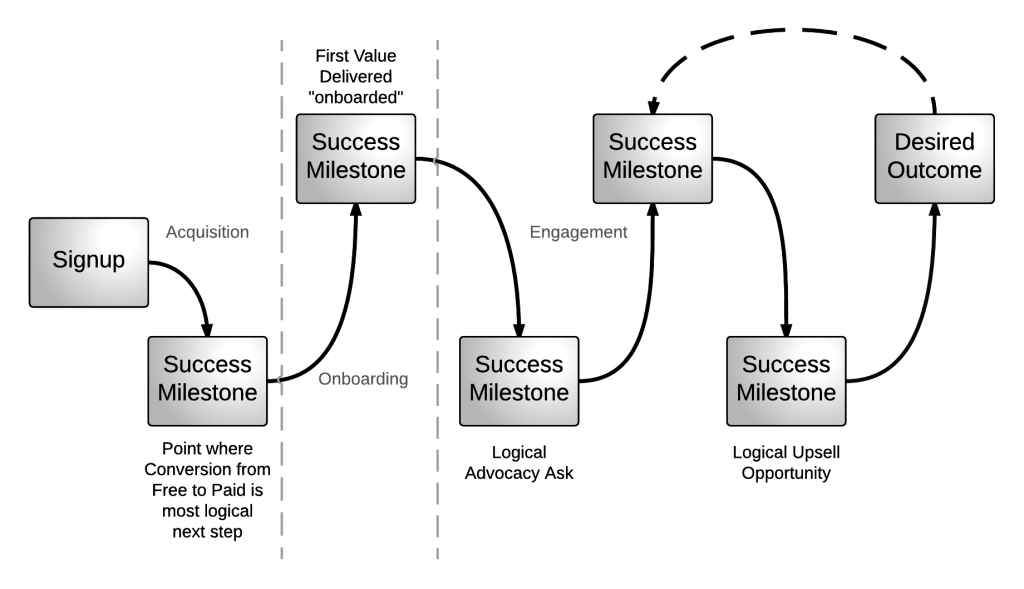
Source: sixteenventures.com
Set up and Monitor Your Customer Success Metrics
Without solid metrics and monitoring, your customer success program won’t go too far. At the very basics, you should keep close tabs on the following metrics:
- Customer Lifetime Value (CLV) — that’s the revenue earned from a single customer over time. The goal of CSM is to help increase that number over time for all customers.
- Net Promoter Score (NPS) — knowing it is essential to understand how you are doing right now, identify struggling/disappointed customers, and line up active Promoters for further collaboration.
- Customer Acquisition Costs (CAC) — if your CAC is higher or equal to your CLV, you are in trouble! Most marketing teams usually know this metric for different marketing channels, so you can borrow the numbers from them.
- Churn rate — denotes the volume of customers that chose to abandon your product at some point. The goal is to keep this number as low as possible.
Most customer success software lets you track these metrics automatically, along with some advanced ones such as Customer Health Score, Qualitative Customer Feedback, Customer Retention Cost, First Contact Resolution Rate, and Renewal rate among others.
Staff your customer success team and ensure strong alignment
Before hiring new specialists, you’ll need to do some essential prep work. First of all, ensure that you have a well-defined, not-too-broad scope of the success manager job.
CSM involves many activities and responsibilities, and a single person won’t be able to effectively cater to them all. So make sure that there are some role divisions. For example, SAP has two distinctive groups of CSM specialists:
- Enterprise support advisors — this division oversees the customer’s access to R&D, support ticket acceleration, and support coordination for cloud and on-premises customers.
- Customer success managers — this group nurtures consultative relationships with cloud customers, provides training, and otherwise helps them gain success with the cloud.
Next, you’ll need to decide how you’ll assign success managers to customers. Forrester recommends going with one of the following options:
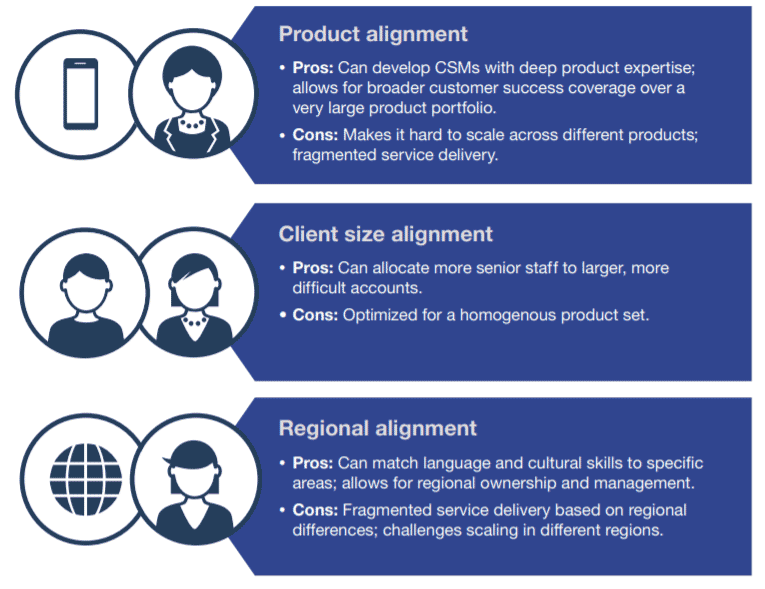
Source: Forrester
Lastly, you’ll need to formalize the skill sets you need among your success managers. Apart from stellar communication and customer service skills, you should also favor people with relevant domain backgrounds. For instance, a financial success manager will need to have some accounting, finance, and analytics skills to speak the client’s language. Software companies should prioritize people with technical backgrounds and so on.
Wrap Up
You can’t build a great customer success program in a day, and perhaps not even in a month. But getting started with this task is essential. Otherwise, you may be overtaken by a more customer-centric competitor on the next turn! So building your business case and brokering stakeholder buy-in cross-department the soonest you can!
